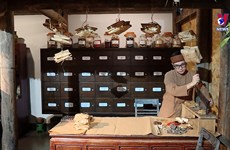Japanese art lovers restore Vietnamese silk paintings
Nguyen Nguyet Tu stands speechless and close to tears before the
beautifully restored silk painting by her late father Nguyen Phan Chanh.
Nguyen Nguyet Tu stands speechless and close to tears before the
beautifully restored silk painting by her late father Nguyen Phan Chanh.
Chanh (1892-1984), considered one of Vietnam 's foremost silk artists, worked prolifically during the war era. Although he lived in turbulent times, Chanh never depicted battle scenes. His art celebrated peace, beauty and the daily lives of local people. He once said he didn't bring war into his paintings because "guns could shoot through silk".
Film producer Tsutomu Nakamura was instantly captivated by the art form, which he saw depicted on a calendar in HCM City and began researching the life and work of the painter.
Chanh, who was among the first students of the Indochina College of Fine Arts (now Hanoi University of Fine Arts), was one of the greatest Vietnamese painters in the 20th century, pioneering his own style and technique of painting on silk.
Before painting, the silk canvas was washed in warm water. When the first layer of colours was finished and dried, he washed the painting again before adding new colours until he was satisfied with the work.
Nakamura read an article in the Japanese edition of the New York Times in 2008 about silk paintings that had been damaged by time, including works by Chanh.
"I wondered how to preserve these paintings for future generations because they didn't just belong to the painter's family and Vietnam but humanity as a whole," he said.
Using his own money, he launched a project to preserve silk works with the help of painters, researchers and filmmakers, who visited Tu's house in 2009.
Tu allowed them to take three damaged paintings – Hun Thuyen (Fumigating the Boats), Co Gai Cuoi Bo Qua Song ( Young Girl Crosses River on Cow's Back) and Don Cui (Cutting Wood) – to Japan for restoration.
The group of Japanese specialists included Kikuko Iwai, who has restored works by Picasso and Monet, came to the painter's homeland to find out more about his life and work.
"To restore Chanh's paintings, I needed to learn more about him and his technique," Iwai said.
She said she had no idea how to restore the colours of the sunset and the girl's appearance in the painting Young Girl Crossing a River on Cow's Back, which were badly damaged.
Knowing that the painter often brought a bottle of water and bread and rode his bicycle along the Hong (Red) River's dyke for inspiration, Iwai said she stood for hours by the river watching the sunset.
She met a couple of farmers, who were aged about 80, on the dyke and asked them what it was like working in the alluvial plain of the river with buffaloes and cows. Their descriptions helped Iwai understand the context of the painting.
When it came to the actual restoration work, she said one of the hardest tasks was to remove the layers of paper pasted on the back of the painting to strengthen it. She also said the silk was extremely fragile. "The silk layer had broken into pieces over time and the paper backing had decayed badly."
She added: "Chanh had to work in extremely poor conditions during the war, so he had to strengthen the painting with bad paper. I feel great admiration for him."
Last year, the restoration work was finished and three paintings were displayed at the 21st Century Museum of Contemporary Art in Japan . Together with the restored works, a film on the restoration process was made in an attempt to capture the project's essence. Interviews with Chanh's daughter and family and his student, painter Nguyen Thu, as well as the work of the Japanese researchers were included in the 57-minute film made by Nihon Denpa News.
Tu was invited to visit the exhibition, which she said was very moving.
"Iwai and I couldn't hold back our tears when seeing the paintings. In a place very far from Vietnam , I felt my father's presence in each painting," Tu said.
"The paintings were seriously damaged but thanks to the Japanese specialists' skill and enthusiasm, they were restored to their former glory."
Chanh's paintings captivated Japanese audiences and art specialists returned to Vietnam last month and took away some more badly damaged paintings.
They plan to open an exhibition of Chanh's work, including the restored painting and artworks borrowed from museums and private collections around the world, in Japan in October.-VNA
Chanh (1892-1984), considered one of Vietnam 's foremost silk artists, worked prolifically during the war era. Although he lived in turbulent times, Chanh never depicted battle scenes. His art celebrated peace, beauty and the daily lives of local people. He once said he didn't bring war into his paintings because "guns could shoot through silk".
Film producer Tsutomu Nakamura was instantly captivated by the art form, which he saw depicted on a calendar in HCM City and began researching the life and work of the painter.
Chanh, who was among the first students of the Indochina College of Fine Arts (now Hanoi University of Fine Arts), was one of the greatest Vietnamese painters in the 20th century, pioneering his own style and technique of painting on silk.
Before painting, the silk canvas was washed in warm water. When the first layer of colours was finished and dried, he washed the painting again before adding new colours until he was satisfied with the work.
Nakamura read an article in the Japanese edition of the New York Times in 2008 about silk paintings that had been damaged by time, including works by Chanh.
"I wondered how to preserve these paintings for future generations because they didn't just belong to the painter's family and Vietnam but humanity as a whole," he said.
Using his own money, he launched a project to preserve silk works with the help of painters, researchers and filmmakers, who visited Tu's house in 2009.
Tu allowed them to take three damaged paintings – Hun Thuyen (Fumigating the Boats), Co Gai Cuoi Bo Qua Song ( Young Girl Crosses River on Cow's Back) and Don Cui (Cutting Wood) – to Japan for restoration.
The group of Japanese specialists included Kikuko Iwai, who has restored works by Picasso and Monet, came to the painter's homeland to find out more about his life and work.
"To restore Chanh's paintings, I needed to learn more about him and his technique," Iwai said.
She said she had no idea how to restore the colours of the sunset and the girl's appearance in the painting Young Girl Crossing a River on Cow's Back, which were badly damaged.
Knowing that the painter often brought a bottle of water and bread and rode his bicycle along the Hong (Red) River's dyke for inspiration, Iwai said she stood for hours by the river watching the sunset.
She met a couple of farmers, who were aged about 80, on the dyke and asked them what it was like working in the alluvial plain of the river with buffaloes and cows. Their descriptions helped Iwai understand the context of the painting.
When it came to the actual restoration work, she said one of the hardest tasks was to remove the layers of paper pasted on the back of the painting to strengthen it. She also said the silk was extremely fragile. "The silk layer had broken into pieces over time and the paper backing had decayed badly."
She added: "Chanh had to work in extremely poor conditions during the war, so he had to strengthen the painting with bad paper. I feel great admiration for him."
Last year, the restoration work was finished and three paintings were displayed at the 21st Century Museum of Contemporary Art in Japan . Together with the restored works, a film on the restoration process was made in an attempt to capture the project's essence. Interviews with Chanh's daughter and family and his student, painter Nguyen Thu, as well as the work of the Japanese researchers were included in the 57-minute film made by Nihon Denpa News.
Tu was invited to visit the exhibition, which she said was very moving.
"Iwai and I couldn't hold back our tears when seeing the paintings. In a place very far from Vietnam , I felt my father's presence in each painting," Tu said.
"The paintings were seriously damaged but thanks to the Japanese specialists' skill and enthusiasm, they were restored to their former glory."
Chanh's paintings captivated Japanese audiences and art specialists returned to Vietnam last month and took away some more badly damaged paintings.
They plan to open an exhibition of Chanh's work, including the restored painting and artworks borrowed from museums and private collections around the world, in Japan in October.-VNA












